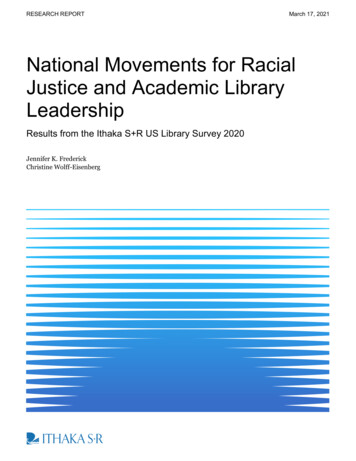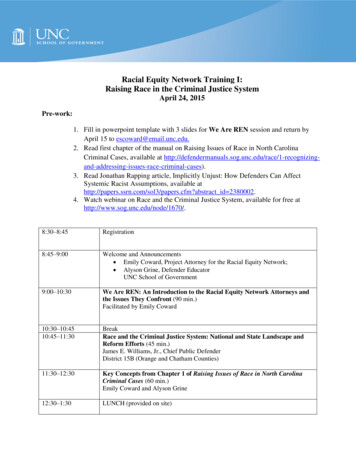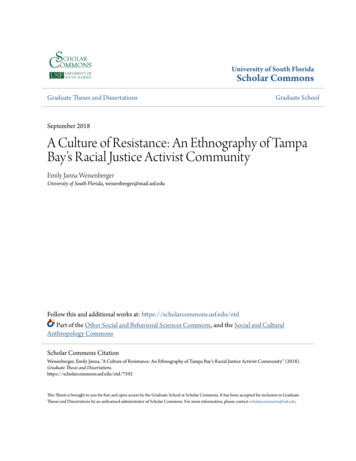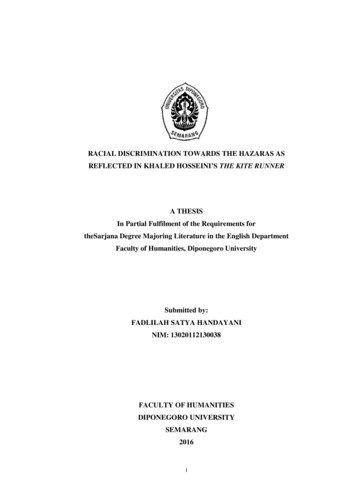
Transcription
RESEARCH REPORTMarch 17, 2021National Movements for RacialJustice and Academic LibraryLeadershipResults from the Ithaka S R US Library Survey 2020Jennifer K. FrederickChristine Wolff-Eisenberg
Ithaka S R provides research and strategic guidance to help the academic and culturalcommunities serve the public good and navigate economic, demographic, and technologicalchange. Ithaka S R is part of ITHAKA, a not-for-profit organization that works to advance andpreserve knowledge and to improve teaching and learning through the use of digitaltechnologies. Artstor, JSTOR, and Portico are also part of ITHAKA.Copyright 2021 ITHAKA. This work is licensed under a Creative Commons Attribution 4.0International License. To view a copy of the license, please HAKA is interested in disseminating this brief as widely as possible. Please contact us withany questions about using the report: research@ithaka.org.We would like to thank the following sponsors for their support of this research:National Movements for Racial Justice and Academic Library Leadership1
Executive SummaryAcademic librarians, like so many others in the higher education and library sectors, havediscussed equity, diversity, and inclusion for many years. A number of prominent initiativeshave worked to address these issues across the profession and within individual institutions.Yet, libraries have struggled to make progress on these stated values, especially in meeting theirgoals of employee diversification.The organizing led by Black Lives Matter activists in 2020 following the murder of George Floydsparked an increase in demands for racial justice across the higher education sector. 1 Manyleaders called for an end to police violence and pledged to address their institutions’ history ofracism. Academic libraries in turn have grappled with renewed attention to increasing thediversity of their employees, addressing retention issues, and fostering equity and inclusion forboth internal and external constituents. Some have also focused their efforts on library practicessuch as increasing the diversity of their collections.To better understand the impact of these national events and long-standing challenges onacademic libraries, we surveyed 638 library directors in fall 2020 to examine how perspectivesand strategies relevant to issues of diversity, equity, inclusion, and anti-racism evolved over thelast year. 2Key Findings Library directors more highly value leadership capacities to foster equity, diversity,and inclusion than previously. Respondents are three times more likely to consider this ability asone of the top three most important skills for directors to possess compared to 2019. Library directors are less confident in their personnel strategies related to equity,diversity, inclusion, and accessibility. Fewer directors believe their libraries have welldeveloped strategies relative to 2019. Leaders at doctoral universities continue to believe theirlibraries have relatively more well-developed strategies. Most library directors did not expect that employees of color would bedisproportionately affected by cuts due to COVID-19. However, job types with relativelygreater percentages of employees of color were more impacted by recent furloughs androle eliminations. Black directors and those at doctoral universities and public institutions sharedrelatively greater concerns about the potential for this happening. The majority of directors have not developed strategies to re-center their collectionsaround authors of color and/or anti-racist content. Likewise, most libraries have notdeveloped criteria for evaluating and making decisions related to the diversity of their collections.See N’dea Yancey-Bragg, “George Floyd’s Brutal Death Sparked a Racial Justice Reckoning. One Officer Involved Goes on Trialthis Month. What You Should Know,” USA Today, 4 March 2021, h-what-know/6889289002/, for more information.12A previous report from the same survey examined results related to strategy and budgeting in response to the COVID-19pandemic: Jennifer K. Frederick and Christine Wolff-Eisenberg, "Academic Library Strategy and Budgeting During the COVID-19Pandemic: Results from the Ithaka S R US Library Survey 2020," Ithaka S R, 9 December 2020,https://doi.org/10.18665/sr.314507.National Movements for Racial Justice and Academic Library Leadership2
IntroductionAcademic libraries have grappled with how to make progress on their stated values of equity,diversity, and inclusion, in particular the racial-ethnic diversity of employees, for some time. Inresponse, library leaders and external organizations have developed numerous programs overthe years to make their organizations, and the field broadly, more equitable, diverse, andinclusive. The Association of Research Libraries (ARL) recently published an overview of suchprograms that appear to hold promise, for example staff and leadership trainings provided bythe Racial Equity Institute and DeEtta Jones & Associates. 3 For several decades, the AmericanLibrary Association (ALA) has hosted the Spectrum Scholarship Program to provide financialsupport to students of color in the library field. 4 Individual libraries have also implementedtemporary diversity fellowships, typically two to three- year programs aimed at helpinglibrarians of color gain experience in the field, such as those supported by the ACRL DiversityAlliance. 5Despite such efforts, little progress has been made in diversifying the field. As demonstrated bythe ALA Diversity Counts study as well as the work of our colleagues at Ithaka S R, academiclibraries remain overwhelmingly white. 67 As Chris Bourg has explored, in 2013, librarians werealmost 30 percentage points more white than the population of the United States as a whole. 8 Ifdiversity efforts continue to lag, this gap will continue to grow. In recent years, April Hathcockhas published several critiques of the library field’s diversity initiatives, detailing the extent towhich recruitment criteria are embedded with whiteness and how retention issues affectemployees of color in particular. 9While these issues are not new to the library field, nor the broader higher education sector, theyhave received renewed visibility and concern over the last year. Following the killing of GeorgeFloyd and increased media attention as a result of grassroots organizing through the Black LivesMatter movement, many higher education leaders issued statements calling for police reformand promising to address historical racism at their institutions. And, at the same time, highereducation institutions navigated the unprecedented set of strategic, financial, and operationalchallenges posed by the COVID-19 pandemic.Kiyomi Deards and Mark A. Puente, “Improving Diversity, Equity, and Inclusion in Libraries: Programs and Methodologies toConsider,” Research Library Issues (301), 2020, https://doi.org/10.29242/rli.301.34For more information, see http://www.ala.org/advocacy/spectrum.5For more information, see “Diversity Counts,” ALA, 2007, rsitycounts/divcounts.Roger C. Schonfeld and Liam Sweeney, “Inclusion, Diversity, and Equity: Members of the Association of Research Libraries:Employee Demographics and Director Perspectives,” Ithaka S R, August 30, 2017, https://doi.org/10.18665/sr.304524.7Chris Bourg, “The Unbearable Whiteness of Librarianship,” Feral Librarian, March 3, he-unbearable-whiteness-of-librarianship/.8April Hathcock, “White Librarianship in Blackface: Diversity Initiatives in LIS,” In the Library With The Lead Pipe, October 7, 15/lis-diversity/; April Hathcock, “Why Don’t You Want to Keep Us?,” At theIntersection, January 18, 2019, -dont-you-want-to-keep-us/.9National Movements for Racial Justice and Academic Library Leadership3
This series of events coupled with broader long-standing issues prompted us to field a specialedition of the Ithaka S R US Library Survey outside our traditional triennial cycle in an effort toprovide an opportunity for library directors to speak collectively on the impact of nationalmovements for racial justice and COVID-19 on their organizations. In the following report, weexplore issues of equity, diversity, inclusion, and anti-racism, highlighting both where directorsperceive progress and where they recognize major challenges remain.On a positive note, we see evidence that as movements for racial justice have recently gainedtraction on a national level, academic library leaders have affirmed their desire to make equity,diversity, inclusion, and anti-racism improvements within their organizations and parentinstitutions. Yet most still lack confidence in the degree to which their personnel and collectionsstrategies support these objectives, and many have not yet recognized how recent budgetary cutshave likely disproportionately affected employees of color in particular.Given the current financial constraints and uncertainty caused by downturns in enrollment, aswell as long-standing and even more recent state defunding of higher education, the work toadvance social and justice imperatives is bound to be made all the more difficult. In such anenvironment, it will be challenging for higher education leaders to make the case for any workthat is not deemed essential, and yet it is clear that there is so much more that can be done toevaluate and improve outcomes, processes, and policies.The data provided in this report help shed light—for higher education leaders, employees,advocates, and funders–on the progress that has been made and the many challenges that stilllie ahead. By recording the collective challenges library leaders across the country are facing, wehope that libraries will be better positioned—collectively and individually—to develop and enactstrategies to address these important issues.MethodologyWe emailed 1,473 library deans and directors at four-year colleges and universities across theUnited States to invite them to participate in our survey in September 2020, and receivedcompleted responses from 638 for an overall response rate of 43 percent. Of these, 83 percentself-identified as white and 64 percent as women. As in previous survey cycles, response ratesdiffered by Carnegie Classification with 35 percent responding from baccalaureate colleges, 42percent participating from master’s institutions, and 53 percent from doctoral universities.Previous cycles of the survey, as well as advisor and tester input, led to the creation of the 2020questionnaire with a particular thematic focus on the impacts of COVID-19 and movements forracial justice.Consistent with previous survey cycles in this series, this study provides insights into thestrategies, priorities, and perspectives of academic library leaders. As library deans and directorsplay an important role in shaping the future of academic libraries, we are able to use thesesurveys to examine the high-level issues of budgeting, staffing, and collections at college anduniversity libraries.National Movements for Racial Justice and Academic Library Leadership4
Many of the questions included in this report include the terms equity, diversity, inclusion,accessibility, and anti-racism. In the survey, we did not define these terms as our survey testers,who were part of our survey population, were able to define them relatively easily. As such, wedid not provide more expansive definitions in the survey.The data gathered were analyzed using a variety of techniques including frequencies and otherdescriptive analyses, independent samples t-tests, one-way ANOVA with Tukey’s HSD tests, andchi-square analyses. Results of these analyses are reported throughout this report if they arestatistically significant at the p .05 level. We have also noted the frequencies of responses overtime, paying particular attention to large differences. See Appendix A for more details onmethodology and Appendix B for a detailed breakdown of respondent demographics.AcknowledgementsWe would like to acknowledge and thank our Library Survey 2020 advisory board for their inputat key stages in this project, especially for their help in establishing the questionnaire. Ouradvisory board includes: K. Matthew Dames, University Librarian, Boston UniversityTrevor A. Dawes, Vice Provost for Libraries and Museums and May Morris UniversityLibrarian, University of DelawareAmy Kautzman, Dean and Director, University Library, Sacramento State UniversityJonathan Miller, Director of Libraries, Williams CollegeKellie O’Rourke, Head of Library Sales, Americas, Cambridge University PressSarah Pickle, Assistant Dean for Planning and Operations, The Claremont CollegesLibrariesDeborah Prosser, Director of Olin Library, Rollins CollegeRachel Rubin, Associate University Librarian for Research and Learning, University ofPittsburghDenise Stephens, Vice Provost and University Librarian, Washington University in St.LouisWe are also grateful to our colleagues who contributed to this project in a variety of ways,including Kimberly Lutz, Roger Schonfeld, Makala Skinner, and Danielle Cooper. In particular,this work would not be possible without the significant contributions of our colleague NicoleBetancourt who administered the survey.National Movements for Racial Justice and Academic Library Leadership5
LeadershipOne of the most important factors for making gains in equity, diversity, inclusion, and antiracism, within and beyond academic libraries, is the clear commitment of leadership towardspecific objectives. In the Library Survey 2020, we explored how the strategies and priorities oflibrary leaders have shifted as a result of increased pressure to improve outcomes forconstituents and employees of color. In this section, we examine the skills library leadersconsider to be valuable for their roles—including the ability to foster equity, diversity, inclusion,and accessibility—and situate our findings in previous work.When we asked academic library directors which areas of knowledge, skill, ability, andcompetency were the three most valuable, the proportion who selected the ability to fosterequity, diversity, inclusion, and accessibility increased dramatically between the 2019 and 2020surveys. In 2019, seven percent of library directors considered fostering equity, diversity,inclusion, and accessibility as a top skill, while in 2020, this percentage increased more thanthree times, to 25 percent. While other skill areas also increased in importance—in particular,skills relating to finances and managing change, perhaps most directly in response to the impactof the pandemic—the biggest increase was in fact for skills related to leading with a focus onequity, diversity, inclusion and accessibility. See Figure 1. It is important to note, however, thatalthough this skill increased the most in importance, it was still chosen by a smaller proportionof library directors than six other skills, making it the fourth-least chosen skill in our set.National Movements for Racial Justice and Academic Library Leadership6
Figure 1. Which of the following knowledge, skills, abilities, and competencies arecurrently most valuable for you in your position? Please select up to three items or leavethe question blank if none of these items apply.Percentage of respondents that selected each item, by survey cycle.Ability to manage changeCommunication skills (e.g. written, oral,interpersonal)Financial skills (e.g. budgeting, financialmanagement)Knowledge of higher education (e.g.teaching, learning, research, and funding)Knowledge of trends in librarianship (e.g.collections, scholarly communications, newservice models, special collections, etc.)Management skills (e.g. recruiting, managingemployee performance)Ability to foster equity, diversity, inclusion,and accessibilityAbility to foster a culture of customer serviceEntrepreneurial and innovation skillsFundraising skills0%201920%40%60%80%100%2020The proportion of library directors who selected the ability to foster equity, diversity, inclusion,and accessibility differed notably by subgroup. At doctoral universities, 31 percent of librarydirectors chose this skill as one of the top three, compared to 22 percent at master’s institutionsand 21 percent at baccalaureate colleges. Similarly, those at public institutions chose the skill ata greater rate with 31 percent deeming it highly important, compared to 20 percent of those atprivate institutions. Further, while there were no statistically significant differences in theproportion of directors who selected this skill by race-ethnicity, a greater share of women (28percent) chose it compared to men (19 percent).National Movements for Racial Justice and Academic Library Leadership7
There are perhaps two possible explanations for the newfound appreciation for these skills.Library leaders may feel that they were able to employ existing skills in a new way, or perhapsthey recognize a gap in their existing abilities. The latter explanation may be bolstered by ananalysis of dozens of academic library strategic plans that we published in May of last year,several months prior to fielding the Library Survey 2020. 10 In analyzing these plans, we foundthat while most mentioned equity, diversity, inclusion, and/or accessibility broadly (e.g.affirming diversifying the library as a goal of the library), indicating at least some level ofcommitment to these issues, few offered concrete goals and plans for advancing relevantobjectives. Given that library directors appear interested in achieving greater equity, diversity,inclusion, and accessibility, as demonstrated by its inclusion in strategic plans, there may be agap between this goal and the strategies needed to obtain it.These findings also beg the question of whether qualifications for library director roles willevolve in response to what may be a recognized gap in existing capacities. An exploratoryanalysis conducted by Ithaka S R with a sample of 33 library director job descriptions posted inthe nine months before and after the murder of George Floyd and subsequent calls across highereducation for addressing racism, there appears to be no change in the share of postings thatmention relevant skills in this area. 11 Both in late 2019 through mid-2020 and in mid-2020through early 2021, roughly half of the job descriptions analyzed invoke any terms related todiversity, equity, and inclusion. And, there were no library director job descriptions in oursample from either time period that mentioned the importance of a commitment to anti-racism.Thus, national movements for racial justice and subsequent commitments from highereducation do not appear to have yet impacted the way that library director roles are envisioned.StrategyImproving equity, diversity, inclusion, and anti-racism does not just require strong leadership,as described in the previous section, but a set of strategies, implementation of those strategies,and mechanisms for measuring change and maintaining accountability. In the Library Survey2020, we included a set of questions on the confidence of leaders in their library’s and theirinstitution’s equity, diversity, inclusion, and anti-racism strategies for personnel and for theirlibrary’s collections.PersonnelOverall, library directors displayed somewhat greater confidence in strategies related to antiracism than those on a broader set of equity, diversity, inclusion, and accessibility imperatives. 12Specifically, a slightly greater share of library directors agreed that their library and theirinstitution have well-developed anti-racist strategies for recruiting and/or retaining employeesJennifer K. Frederick and Christine Wolff-Eisenberg, “Measuring What Matters: Equity, Diversity, Inclusion, and Accessibility inAcademic Library Strategic Plans,” Ithaka S R, May 26, 2020, .10An equivalent analysis has not yet been conducted for library employee roles, though this would shed light on how librarydirectors are updating the skills within their own organizations.1112See Appendix C for the full set of questions.National Movements for Racial Justice and Academic Library Leadership8
compared to more general strategies to improve equity, diversity, inclusion, and accessibility foremployees at both the library and the institutional level. Within the library, 35 percent of librarydirectors strongly agree that they have well-developed anti-racist strategies for recruitment andretention compared to 31 percent who believe their library has well-developed equity, diversity,inclusion, and accessibility strategies for employees. Similarly, 31 percent and 26 percentrespectively believe that their institution has well-developed anti-racist strategies and equity,diversity, inclusion, and accessibility strategies. See Figure 2.The directionality of these pairs of findings—that is, that there was greater confidence instrategies for recruitment and retention related to anti-racism than on equity, diversity,inclusion, and accessibility—is perhaps surprising given how often equity, diversity, inclusion,and accessibility tend to show up in key library documentation, namely job descriptions andstrategic plans, and how infrequently anti-racism is invoked. It is possible that respondentsviewed the items related to anti-racism as pertaining to legal compliance and antidiscrimination, whereas the other statements and associated strategies are broader and gobeyond these legal requirements. Additional research on how these terms are—and perhapsshould be—used and operationalized would be merited. 13While analysis has been conducted on institution-wide anti-racism statements from 2020 which were typically issued by collegeand university presidents (e.g. Kurubel Belay, “What Has Higher Education Promised on Anti-Racism in 2020 and Is It Enough?”EAB, November 16, 2020 igher-education-promise-anti-racism/), no equivalentanalyses or compilations of statements could be found for academic libraries.13National Movements for Racial Justice and Academic Library Leadership9
Figure 2. Please use the 10 to 1 scales to indicate your level of agreement with eachstatement—a 10 equals “strongly agree” and a 1 equals “strongly disagree.”Percentage of respondents that strongly agree with each statement, by survey cycle.My library has well-developed anti-raciststrategies for recruiting and/or retainingemployees.My institution has well-developed anti-raciststrategies for recruiting and/or retainingemployees.My library has well-developed strategies forimproving equity, diversity, inclusion, andaccessibility for its employees.My institution has well-developed strategiesfor improving equity, diversity, inclusion, andaccessibility for its employees.0%201920%40%60%80%100%2020It is also notable that confidence in personnel strategies has declined over the last year. Since2019, a smaller share of library directors saw their equity, diversity, inclusion, and accessibilitystrategies as well-developed, especially at the institution level; about eight percent fewerstrongly agree with the statement regarding their institution. As in the 2019 survey, a greatershare of library directors at doctoral institutions compared to those at other institution typesstrongly agreed that their equity, diversity, inclusion, and accessibility strategies were welldeveloped, but only at the library level; 38 percent of those at doctoral universities stronglyagreed, compared to 29 percent at master’s institutions and 26 percent at baccalaureatecolleges.Further, 40 percent of library directors of color were confident in their equity, diversity,inclusion, and accessibility strategies, 14 with 41 percent of Black directors specifically stronglyagreeing. 15 A smaller share of white library directors agreed (29 percent). Similarly, there was agap in confidence between white directors and directors of color in whether their institution hadwell-developed equity, diversity, inclusion, and accessibility strategies, with 24 percent of whitedirectors strongly agreeing and 35 percent of directors of color strongly agreeing (31 percent ofBlack library directors strongly agreed). See Figure 3. Both directors of color in general andBlack directors specifically are more likely to be library directors at doctoral universities. GivenHere, library directors of color refer to respondents who did not solely select that they were white. Respondents who selectedmultiple racial-ethnic identities were included in the employees of color category even if they selected white as one of their identities.14We separately examined how Black directors responded to each of the questions for two reasons: 1) the recent movements forracial justice specifically sought to address police violence against Black people and 2) there were enough Black respondents in thesurvey (i.e. more than 30) to run statistical analysis while also maintaining the confidentiality of respondents.15National Movements for Racial Justice and Academic Library Leadership 10
that library directors at doctoral universities tend to be more confident in their equity, diversity,inclusion, and accessibility strategies, this may partially explain these findings. It is also possiblethat that personal, identity-based experiences with the impact of racism have in part shapedhow strategies are developed within the library and more broadly influenced within the parentinstitution.Figure 3. Please use the 10 to 1 scales to indicate your level of agreement with eachstatement—a 10 equals “strongly agree” and a 1 equals “strongly disagree.”Percentage of respondents that strongly agree with each statement, by race-ethnicity.*My library has well-developed anti-raciststrategies for recruiting and/or retainingemployees.My institution has well-developed anti-raciststrategies for recruiting and/or retainingemployees.My library has well-developed strategies forimproving equity, diversity, inclusion, andaccessibility for its employees.My institution has well-developed strategiesfor improving equity, diversity, inclusion, andaccessibility for its ck refers to all library directors that selected a race-ethnicity category other than Black/African American.Those who selected Black/African American and another race-ethnicity group were categorized as Black.Additionally, a smaller proportion of library directors at institutions in the Northeast wereconfident in their library’s strategies compared to those at institutions in the Southeast (25percent versus 39 percent). This may be due to the Southeast’s greater racial diversity in thegeneral population compared to the Northeast and the greater share of Black library directorsspecifically at Southeast institutions (17 percent) compared to in the Northeast (six percent). 16Finally, a smaller share of women, compared to men, were confident in their institution’sstrategies (23 percent versus 32 percent).Further, the Southeast had the greatest share of Black library directors compared to all other regions. The next greatest sharewas at institutions in the Southwest with 12 percent of library directors identifying as Black. in all other regions fewer than 10 percentof library directors were Black.16National Movements for Racial Justice and Academic Library Leadership 11
To get a sense of what some of these equity, diversity, inclusion, and accessibility strategies havelooked like at academic libraries, we turn to the findings from our prior library director surveycycle in 2019. In that survey, fielded just months prior to the COVID-19 pandemic, we askedlibrary directors for the first time what strategies they or those involved in hiring at theirlibraries use when recruiting and hiring library employees. These strategies were intended tomeasure what actions, if any, library directors or those involved in hiring were taking to maketheir libraries more diverse. 17The most common practices are separating out minimum requirements and preferred skills injob advertisements and using structured interview scripts for each applicant (89 percent and 74percent respectively). Nearly half also required parties involved in selection to be formallytrained on equity, diversity, inclusion, and accessibility. Fewer than one-third utilized theremaining practices. See Figure 4. These activities are likely among those that directors reflectedon while answering questions about their broader strategies and may therefore in part explainwhy many are not particularly confident in their personnel strategies for improving equity,diversity, inclusion, and accessibility. Given that many library leaders at the director level arenot solely responsible for developing and carrying out hiring practices, collaboration with otherhiring managers and human resources professionals is essential for revisiting these practices.These practices were selected based on ALA recommendations and desk research (Tara Sophia Mohr, “Why Women Don’t Applyfor Jobs Unless They’re 100% Qualified,” Harvard Business Review, August 25, 2014, bs-unless-theyre-100-qualified; DeEtta Jones, “The Inclusive Manager’s Hiring Checklist, df ), feedback from advisors, as well as issues that thefirst author engaged with while conducting research at the University of Michigan. See “Stride,” The University of Michigan’sAdvance Program, https://advance.umich.edu/stride/
Leadership . Results from the Ithaka S R US Library Survey 2020 . Jennifer K. Frederick . preserve knowledge and to improve teaching and learning through the use of digital . surveys to examine the high-level issues of budgeting, staffing, and collections at college and university libraries. National Movements for Racial Justice and .










